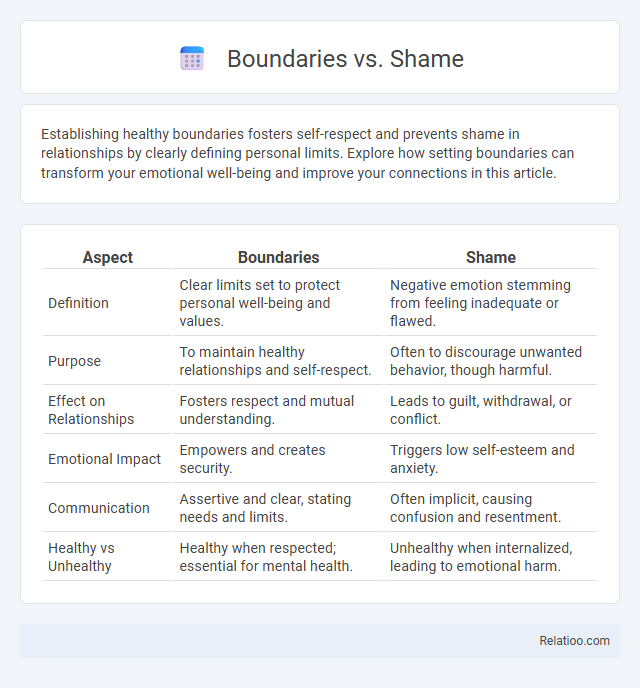Establishing healthy boundaries fosters self-respect and prevents shame in relationships by clearly defining personal limits. Explore how setting boundaries can transform your emotional well-being and improve your connections in this article.
Table of Comparison
| Aspect | Boundaries | Shame |
|---|---|---|
| Definition | Clear limits set to protect personal well-being and values. | Negative emotion stemming from feeling inadequate or flawed. |
| Purpose | To maintain healthy relationships and self-respect. | Often to discourage unwanted behavior, though harmful. |
| Effect on Relationships | Fosters respect and mutual understanding. | Leads to guilt, withdrawal, or conflict. |
| Emotional Impact | Empowers and creates security. | Triggers low self-esteem and anxiety. |
| Communication | Assertive and clear, stating needs and limits. | Often implicit, causing confusion and resentment. |
| Healthy vs Unhealthy | Healthy when respected; essential for mental health. | Unhealthy when internalized, leading to emotional harm. |
Understanding Boundaries: A Foundation for Healthy Relationships
Understanding boundaries establishes a crucial framework for distinguishing between shame and guilt in interpersonal dynamics. Boundaries define personal limits and foster respect, preventing the internalization of shame, which often stems from perceived personal flaws, unlike guilt that relates to specific behaviors. Prioritizing clear communication and self-awareness in setting boundaries enhances emotional well-being and strengthens healthy relationships by promoting accountability without diminishing self-worth.
Defining Shame: Origins and Impact
Shame originates from early experiences where personal boundaries were violated or unmet, leading to a deep sense of unworthiness or inadequacy. It profoundly impacts emotional well-being by shaping your self-perception and influencing how you relate to others, often causing feelings of isolation or self-criticism. Understanding these roots helps differentiate shame from guilt, which targets specific behaviors rather than intrinsic self-worth.
The Key Differences Between Boundaries and Shame
Boundaries are healthy personal limits that protect individual well-being and foster respect in relationships, whereas shame is a painful emotion linked to feeling flawed or unworthy. Boundaries are assertive actions rooted in self-respect and autonomy, while shame often leads to withdrawal and self-criticism. Understanding these differences is crucial for emotional resilience, allowing individuals to maintain clear limits without internalizing negative self-judgments.
How Healthy Boundaries Foster Self-Respect
Healthy boundaries create a clear distinction between personal values and external expectations, reinforcing self-respect and emotional well-being. By recognizing and asserting limits, individuals avoid guilt and shame that arise from overstepping or compromising their true selves. This empowerment promotes authentic relationships, reducing toxic dynamics and enhancing psychological resilience.
The Destructive Cycle of Shame-Based Thinking
Shame-based thinking traps individuals in a destructive cycle where internalized shame blurs personal boundaries, leading to excessive guilt and self-blame. This pattern undermines self-esteem and fosters emotional distress by distorting reality and amplifying feelings of unworthiness. Effective boundary-setting interrupts this cycle, promoting emotional resilience and healthier self-perception.
Setting Boundaries Without Guilt or Shame
Setting boundaries is essential for maintaining healthy relationships and protecting your well-being, and it's important to distinguish this from feelings of shame or guilt that often arise unnecessarily. Boundaries clarify your limits and needs, whereas guilt stems from feeling responsible for others' emotions, and shame attacks your sense of self-worth. You can enforce your personal boundaries confidently by recognizing that prioritizing your mental and emotional health is a necessary act of self-respect, not something to feel guilty or ashamed about.
Cultural Influences on Boundaries and Shame
Cultural influences significantly shape how boundaries and shame are perceived, with some societies emphasizing collective harmony over individual limits, leading to blurred personal boundaries and heightened shame when social expectations are unmet. Your sense of guilt often intertwines with cultural norms, where deviations from group standards trigger internalized shame rather than personal accountability. Understanding these dynamics helps you navigate social interactions by recognizing that boundaries and shame are deeply embedded in cultural context and collective values.
Common Signs You Are Confusing Boundaries with Shame
Common signs you are confusing boundaries with shame include feeling excessive guilt or self-blame when asserting limits, interpreting others' discomfort as proof of your wrongdoing, and avoiding expressing personal needs to prevent perceived rejection. This confusion often leads to over-apologizing, difficulty saying no, and internalizing criticism as a reflection of personal failure rather than healthy boundary-setting. Recognizing these signs helps differentiate between protecting your well-being and internalizing shame, promoting emotional resilience and clearer interpersonal dynamics.
Practical Strategies to Move from Shame to Empowered Boundaries
Recognizing the difference between boundaries, shame, and guilt is crucial for personal growth and emotional well-being. Practical strategies to move from shame to empowered boundaries include identifying your core values, practicing assertive communication, and engaging in self-compassion exercises to replace self-judgment with self-respect. Focusing on these steps helps you establish healthy limits that protect your emotional space and foster resilience.
Embracing Growth: Reframing Shame through Boundary Setting
Reframing shame through boundary setting promotes emotional growth by distinguishing personal limits from feelings of guilt. Establishing clear boundaries empowers individuals to honor their needs without internalizing shame as a reflection of worth. This process fosters self-respect and resilience, transforming shame into a catalyst for healthy emotional development.

Infographic: Boundaries vs Shame
 relatioo.com
relatioo.com